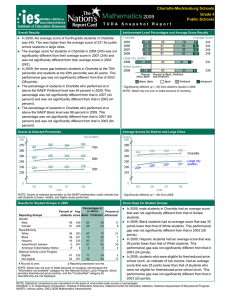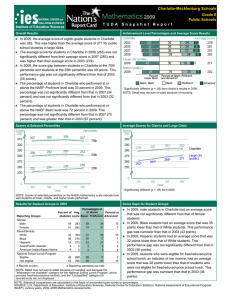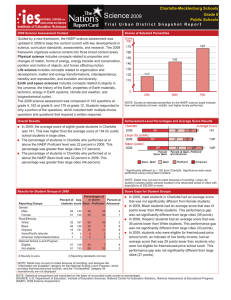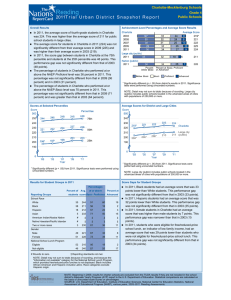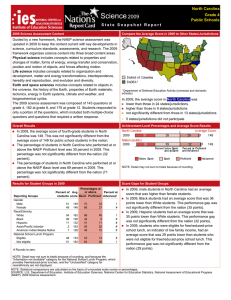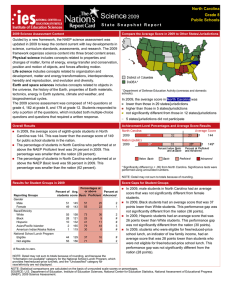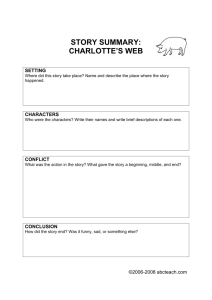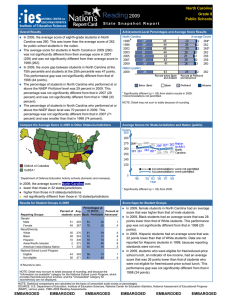Reading 2009 T r i a l U r b ... Charlotte-Mecklenburg Schools
advertisement
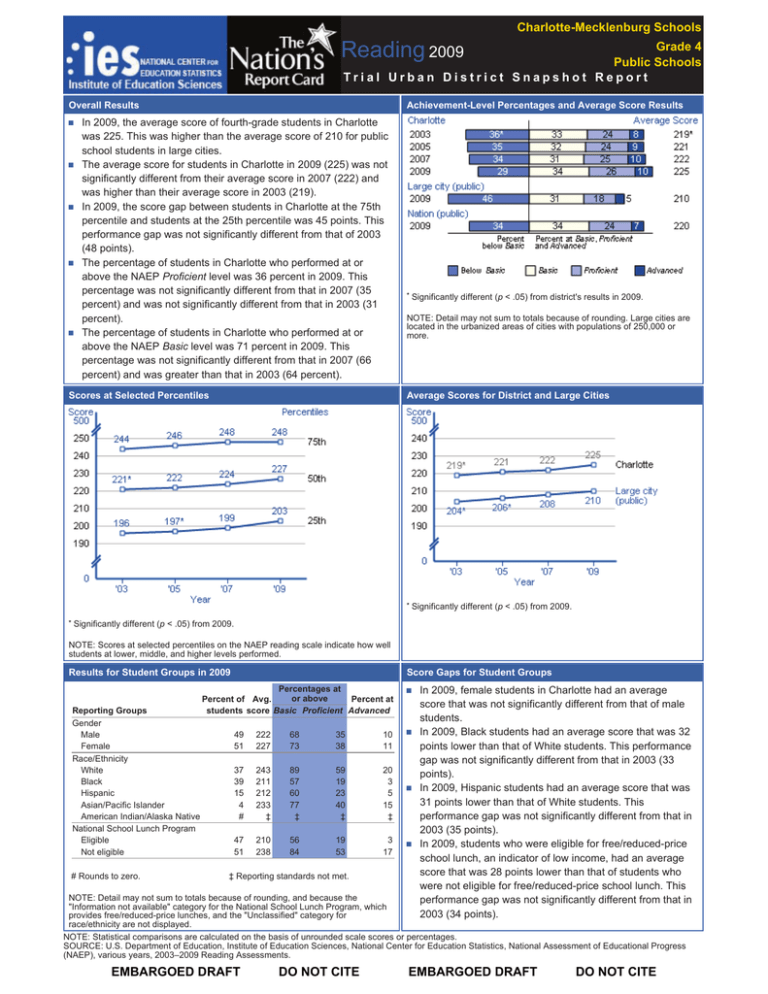
Charlotte-Mecklenburg Schools Reading 2009 Grade 4 Public Schools Trial Urban District Snapshot Report Overall Results Achievement-Level Percentages and Average Score Results In 2009, the average score of fourth-grade students in Charlotte was 225. This was higher than the average score of 210 for public school students in large cities. The average score for students in Charlotte in 2009 (225) was not significantly different from their average score in 2007 (222) and was higher than their average score in 2003 (219). In 2009, the score gap between students in Charlotte at the 75th percentile and students at the 25th percentile was 45 points. This performance gap was not significantly different from that of 2003 (48 points). The percentage of students in Charlotte who performed at or above the NAEP Proficient level was 36 percent in 2009. This percentage was not significantly different from that in 2007 (35 percent) and was not significantly different from that in 2003 (31 percent). The percentage of students in Charlotte who performed at or above the NAEP Basic level was 71 percent in 2009. This percentage was not significantly different from that in 2007 (66 percent) and was greater than that in 2003 (64 percent). Scores at Selected Percentiles * NOTE: Detail may not sum to totals because of rounding. Large cities are located in the urbanized areas of cities with populations of 250,000 or more. Average Scores for District and Large Cities * * Significantly different (p < .05) from district's results in 2009. Significantly different (p < .05) from 2009. Significantly different (p < .05) from 2009. NOTE: Scores at selected percentiles on the NAEP reading scale indicate how well students at lower, middle, and higher levels performed. Results for Student Groups in 2009 Reporting Groups Gender Male Female Race/Ethnicity White Black Hispanic Asian/Pacific Islander American Indian/Alaska Native National School Lunch Program Eligible Not eligible # Rounds to zero. Score Gaps for Student Groups Percentages at or above Percent at Percent of Avg. students score Basic Proficient Advanced 49 51 222 227 68 73 35 38 10 11 37 39 15 4 # 243 211 212 233 ‡ 89 57 60 77 ‡ 59 19 23 40 ‡ 20 3 5 15 ‡ 47 51 210 238 56 84 19 53 3 17 ‡ Reporting standards not met. In 2009, female students in Charlotte had an average score that was not significantly different from that of male students. In 2009, Black students had an average score that was 32 points lower than that of White students. This performance gap was not significantly different from that in 2003 (33 points). In 2009, Hispanic students had an average score that was 31 points lower than that of White students. This performance gap was not significantly different from that in 2003 (35 points). In 2009, students who were eligible for free/reduced-price school lunch, an indicator of low income, had an average score that was 28 points lower than that of students who were not eligible for free/reduced-price school lunch. This performance gap was not significantly different from that in 2003 (34 points). NOTE: Detail may not sum to totals because of rounding, and because the "Information not available" category for the National School Lunch Program, which provides free/reduced-price lunches, and the "Unclassified" category for race/ethnicity are not displayed. NOTE: Statistical comparisons are calculated on the basis of unrounded scale scores or percentages. SOURCE: U.S. Department of Education, Institute of Education Sciences, National Center for Education Statistics, National Assessment of Educational Progress (NAEP), various years, 2003–2009 Reading Assessments. EMBARGOED DRAFT DO NOT CITE EMBARGOED DRAFT DO NOT CITE Charlotte-Mecklenburg Schools Reading 2009 Grade 8 Public Schools Trial Urban District Snapshot Report Overall Results Achievement-Level Percentages and Average Score Results In 2009, the average score of eighth-grade students in Charlotte was 259. This was higher than the average score of 252 for public school students in large cities. The average score for students in Charlotte in 2009 (259) was not significantly different from their average score in 2007 (260) and was not significantly different from their average score in 2003 (262). In 2009, the score gap between students in Charlotte at the 75th percentile and students at the 25th percentile was 46 points. This performance gap was not significantly different from that of 2003 (48 points). The percentage of students in Charlotte who performed at or above the NAEP Proficient level was 28 percent in 2009. This percentage was not significantly different from that in 2007 (29 percent) and was not significantly different from that in 2003 (30 percent). The percentage of students in Charlotte who performed at or above the NAEP Basic level was 70 percent in 2009. This percentage was not significantly different from that in 2007 (69 percent) and was not significantly different from that in 2003 (71 percent). Scores at Selected Percentiles NOTE: Detail may not sum to totals because of rounding. Large cities are located in the urbanized areas of cities with populations of 250,000 or more. Average Scores for District and Large Cities * Significantly different (p < .05) from 2009. NOTE: Scores at selected percentiles on the NAEP reading scale indicate how well students at lower, middle, and higher levels performed. Results for Student Groups in 2009 Reporting Groups Gender Male Female Race/Ethnicity White Black Hispanic Asian/Pacific Islander American Indian/Alaska Native National School Lunch Program Eligible Not eligible # Rounds to zero. Score Gaps for Student Groups Percentages at or above Percent of Avg. Percent at students score Basic Proficient Advanced 50 50 252 267 63 77 20 35 1 4 32 47 14 4 # 276 249 254 ‡ ‡ 87 60 64 ‡ ‡ 48 15 18 ‡ ‡ 5 # 2 ‡ ‡ 46 52 248 270 59 80 15 39 1 4 ‡ Reporting standards not met. In 2009, female students in Charlotte had an average score that was higher than that of male students. In 2009, Black students had an average score that was 28 points lower than that of White students. This performance gap was not significantly different from that in 2003 (30 points). In 2009, Hispanic students had an average score that was 23 points lower than that of White students. This performance gap was not significantly different from that in 2003 (34 points). In 2009, students who were eligible for free/reduced-price school lunch, an indicator of low income, had an average score that was 21 points lower than that of students who were not eligible for free/reduced-price school lunch. This performance gap was narrower than that in 2003 (29 points). NOTE: Detail may not sum to totals because of rounding, and because the "Information not available" category for the National School Lunch Program, which provides free/reduced-price lunches, and the "Unclassified" category for race/ethnicity are not displayed. NOTE: Statistical comparisons are calculated on the basis of unrounded scale scores or percentages. SOURCE: U.S. Department of Education, Institute of Education Sciences, National Center for Education Statistics, National Assessment of Educational Progress (NAEP), various years, 2003–2009 Reading Assessments. EMBARGOED DRAFT DO NOT CITE EMBARGOED DRAFT DO NOT CITE
